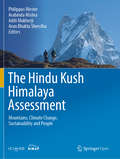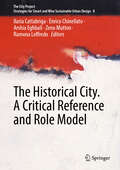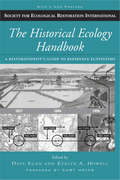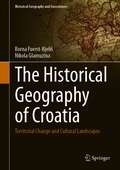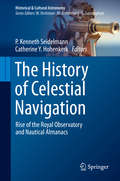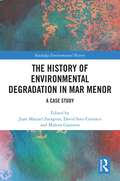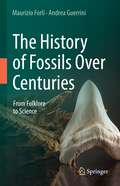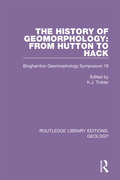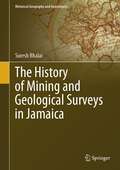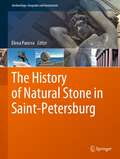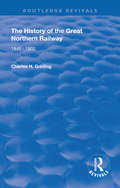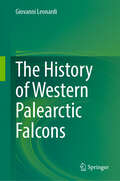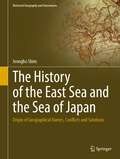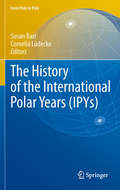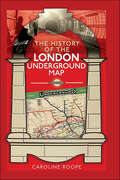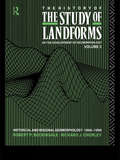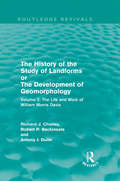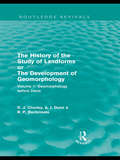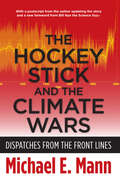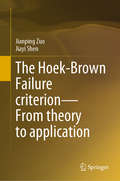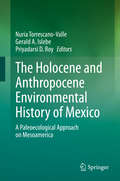- Table View
- List View
The Hindu Kush Himalaya Assessment: Mountains, Climate Change, Sustainability and People
by Philippus Wester Arabinda Mishra Aditi Mukherji Arun Bhakta ShresthaThis open access volume is the first comprehensive assessment of the Hindu Kush Himalaya (HKH) region. It comprises important scientific research on the social, economic, and environmental pillars of sustainable mountain development and will serve as a basis for evidence-based decision-making to safeguard the environment and advance people’s well-being. The compiled content is based on the collective knowledge of over 300 leading researchers, experts and policymakers, brought together by the Hindu Kush Himalayan Monitoring and Assessment Programme (HIMAP) under the coordination of the International Centre for Integrated Mountain Development (ICIMOD). This assessment was conducted between 2013 and 2017 as the first of a series of monitoring and assessment reports, under the guidance of the HIMAP Steering Committee: Eklabya Sharma (ICIMOD), Atiq Raman (Bangladesh), Yuba Raj Khatiwada (Nepal), Linxiu Zhang (China), Surendra Pratap Singh (India), Tandong Yao (China) and David Molden (ICIMOD and Chair of the HIMAP SC).This First HKH Assessment Report consists of 16 chapters, which comprehensively assess the current state of knowledge of the HKH region, increase the understanding of various drivers of change and their impacts, address critical data gaps and develop a set of evidence-based and actionable policy solutions and recommendations. These are linked to nine mountain priorities for the mountains and people of the HKH consistent with the Sustainable Development Goals. This book is a must-read for policy makers, academics and students interested in this important region and an essentially important resource for contributors to global assessments such as the IPCC reports.
The Historical City. A Critical Reference and Role Model (The City Project #8)
by Ilaria Cattabriga Enrico Chinellato Arshia Eghbali Zeno Mutton Ramona LoffredoThis book offers a multivocal and interdisciplinary arena that brings together a wide range of thoughts and approaches addressing the intricacies of dealing with the historical city today. Spanning across a multitude of humanistic, sociological, and technological outlooks, it provides a multifaceted overview of current research on the city and its historicity. Based on revised and extended contributions presented at two international conferences, namely “The Historical City as a Critical Reference and Role Model for Innovative Urban and Metropolitan Development” (January 26-27, 2023) and “The Historical City as a Field for Critical Exercise. Criticism, Politics, Actors (April 17, 2023), both held at the University of Bologna, this book is an insightful and thought-provoking read for researchers in Architecture, History, Urban Studies, Social Sciences, and the Arts, as well as professionals and policy makers dealing with historical cities.
The Historical Ecology Handbook: A Restorationist's Guide to Reference Ecosystems (Science Practice Ecological Restoration)
by Dave Egan Curt Meine Evelyn A. HowellThe Historical Ecology Handbook makes essential connections between past and future ecosystems, bringing together leading experts to offer a much-needed introduction to the field of historical ecology and its practical application by on-the-ground restorationists.Chapters present individual techniques focusing on both culturally derived evidence and biological records, with each chapter offering essential background, tools, and resources needed for using the technique in a restoration effort. The book ends with four in-depth case studies that demonstrate how various combinations of techniques have been used in restoration projects.The Historical Ecology Handbook is a unique and groundbreaking guide to determining historic reference conditions of a landscape. It offers an invaluable compendium of tools and techniques, and will be essential reading for anyone working in the field of ecological restoration.
The Historical Geography of Croatia: Territorial Change and Cultural Landscapes (Historical Geography and Geosciences)
by Borna Fuerst-Bjeliš Nikola GlamuzinaThis monograph gives a comprehensive but in-depth analysis of the territorial development of Croatia and historical processes of significant spatial impact. It covers the millennial time span – from prehistory till the present, through relevant periods, e.g., prehistory, antiquity, Middle Ages, period of Ottoman progression and retreat, Post-Ottoman period of development of the Central European railway network, the period of South Slavic political associations (old and new Yugoslavia), and the post-Yugoslav period of independent Croatia. The book is highly illustrated with maps and figures. It is written by scholars from the region, based on the original research and the vast body of literature. It is one of the only books in English that interprets the overall development of the territory and cultural landscape of Croatia. Its scientific but comprehensive approach makes it of use to scholars, students and anyone interested in historical and geographical processes and features of Croatia and the Balkan region.
The History of Celestial Navigation: Rise of the Royal Observatory and Nautical Almanacs (Historical & Cultural Astronomy)
by P. Kenneth Seidelmann Catherine Y. HohenkerkThis edited volume charts the history of celestial navigation over the course of five centuries. Written by a group of historians and scientists, it analyzes how competing navigation systems, technologies, and institutions emerged and developed, with a focus on the major players in the US and the UK.The history covers the founding of the Royal Observatory; the first printing of a Nautical Almanac; the founding of the US and UK Nautical Almanac Offices; the creation of international standards for reference systems and astronomical constants; and the impact of 20th century technology on the field, among other topics. Additionally, the volume analyzes the present role and status of celestial navigation, particularly with respect to modern radio and satellite navigation systems.With its diverse authorship and nontechnical language, this book will appeal to any reader interested in the history of science, technology, astronomy, and navigation over the ages.
The History of Environmental Degradation in Mar Menor: A Case Study (Routledge Environmental History)
by Juan Manuel Zaragoza David Soto Malena CanteroThis book offers a multidisciplinary analysis of the degradation process of an ecosystem, drawing upon the Mar Menor as a case study to highlight the damage human pressure causes to the environment.All ecosystems change over time, although in some cases, this variation is more dynamic and evident. The Mar Menor is a clear example of this “ecological transition”, as it is the largest coastal lagoon in the western Mediterranean and the first ecosystem in Europe to be granted legal personhood rights. This book provides an extensive overview of the history of its environmental degradation over the past 100 years, highlighting the subsequent succession of environmental crises including phytoplankton explosions, the disappearance of large areas of submerged meadows due to eutrophication, and episodes of mass mortality of aquatic fauna. Split into three sections to reflect thematic blocks, the book begins with a comprehensive description of the Mar Menor and its marine ecosystems, emphasizing its ecological value and unique space in Spain and Europe. It discusses intensive and globalized agriculture, surrounding agro‑export, and the laws that legislate it. In the second part, the book draws on a series of cultural concepts, theoretical frameworks, and participatory arts‑based research to enrich our understanding of the environment from multiple perspectives. Finally, in the third part, the book uses analysis gathered from the Mar Menor case study to discuss wider conclusions about the ways in which we can begin to undo our damage to the environment and restore ecosystems.This book will be useful for students, academics, and researchers interested in environmental justice, environmental history and anthropology, sustainable development, and environmental studies more broadly.
The History of Fossils Over Centuries: From Folklore to Science
by Andrea Guerrini Maurizio ForliThis book discusses the history of invertebrate fossil understanding and classification by exploring fossil studies between the 15th and 18th centuries. Before the modern age, the understanding of fossil findings went through several phases. The treatment by philologists, philosophers and historians of natural sciences involved religious, sometimes folkloristic, aspects before scientific ones. This work showcases and assesses these original findings by carrying out a bibliographical, and above all iconographical research, aimed at finding the first printed images of the objects that we now know as fossils. From here, the authors provide an understanding of the true nature of fossils by analyzing them through modern academic viewpoints, and describing each fossil group from a paleontological and taxonomic point of view, retracing their treatment in the course of the centuries.As a point of reference for each fossil group treated, the authors have considered indispensable the use of ancient prints as evidence of the first iconographic sources dedicated to fossils, starting from those in the late fifteenth century, dedicated to the most common groups of invertebrates without neglecting a necessary exception, the ichthyodontolites, fundamental in the discussion in Italy on the interpretation of the organic origin of fossils, and from the end of the sixteenth century to about half of the eighteenth century. The abundant iconographic apparatus used, often unpublished or specially reworked, is essential and functional to the understanding of the various aspects addressed, a visual complement to the text and vice versa, designed and used taking its cue from the need imposed on early scholars to document their discoveries visually. Among the chosen images there is no shortage of original attributions to fossil finds that have been poorly understood or misidentified until now.The English translation of this book from its Italian original manuscript was done with the help of artificial intelligence (machine translation by the service provider DeepL.com). A subsequent human revision of the content was done by the authors.
The History of Geomorphology: From Hutton to Hack: Binghamton Geomorphology Symposium 19 (Routledge Library Editions: Geology #20)
by K. J. TinklerThis book, first published in 1989, the proceedings of the 19th Binghamton Geomorphology Symposium, is the first set of essays focused on the history of the subject. The articles analyse the founding precepts of geomorphology, the early pioneers, the formation of a defined discipline, and the present state of the topic.
The History of Global Climate Governance
by Joyeeta GuptaWhat has happened globally on the climate change issue? How have countries' positions differed over time, and why? How are problems and politics developing on an increasingly globalised planet, and can we find a solution? This book explores these questions and more, explaining the key underlying issues of the conflicts between international blocs. The negotiation history is systematically presented in five phases, demonstrating the evolution of decision-making. The book discusses the coalitions, actors and potential role of the judiciary, as well as human rights issues in addressing the climate change problem. It argues for a methodical solution through global law and constitutionalism, which could provide the quantum jump needed in addressing the problem of climate governance. This fascinating and accessible account will be a key resource for policymakers and NGOs, and also for researchers and graduate students in climate policy, geopolitics, climate change, environmental policy and law, and international relations.
The History of Mining and Geological Surveys in Jamaica (Historical Geography and Geosciences)
by Suresh BhalaiMining and geological survey work in Jamaica goes back several hundred years and was initiated by the Europeans when they colonized the Island. The year 2019 marked 160 years since the first Government-commissioned Geological Survey of Jamaica. This is one of the oldest survey activity of this type in the World! This book seeks to commemorate this heritage. It is one of the first books of its kind examining the evolution of the mineral sector and geological survey work of Jamaica, set in the framework of the Country's history of over 500 years. The Reader will explore a relatively unfamiliar side of the Country's development, linked to popular historical stories that shaped the Nation. The information presented are mostly documented in dated academic literature that are not gauged for a wide audience. This book however, aims to make this information accessible for a wider readership such as students, amateur scientist, non-professionals or anyone who wishes to learn about the rich history and heritage, and the contributions to national development from Europe and much later, North America.
The History of Natural Stone in Saint-Petersburg (Geoheritage, Geoparks and Geotourism)
by Elena PanovaThe book introduces readers to the heritage of St. Petersburg, sharing the geological history of a unique city, a world heritage site, and part of the UNESCO list. It also explains the role of small towns and fortresses near St. Petersburg, whose stone decoration played an essential role in the city’s evolution and was key in the history of neighboring cultures. The book also describes the main architectural symbols of St. Petersburg, such as the Alexander Column, the Bronze Horseman, the Peter and Paul Fortress and more. In addition to five guided tours of the city center, it offers descriptions of historic quarries, some of which are now open-air museums.
The History of The Great Northern Railway: 1845 - 1902 (Routledge Revivals)
by Charles H. GrinlingPublished in 1903, this book provides a complete account of the origin and development of the Great Northern Railway Company from its inception to the year 1802, a period of around 60 years.
The History of Western Palearctic Falcons
by Giovanni LeonardiFalcons have been exploited by humans as food source, ornamental purposes or for the falconry practices. There is a large historical literature in which falcons were often mentioned but always along broader topics (mainly ancient falconry and poetry). This book is the result of a parallel project developed during the preparation of "Behavioral Ecology of Western Palearctic falcons" (published by Springer in 2020). The main aim is to use archaeological and historical sources on falcons to delineate the past distribution and population ecology of these predators in the Western Palearctic ecozone. Ultimately, the approach to the data is aimed at defining the population dynamics of falcons over time. The relationship/conflict with human populations is also placed in this context. By putting falcons as a central subject of study, this book outlines their path in the Western Palearctic from the Pleistocene to modern ornithology.
The History of the Countryside
by Oliver RackhamFrom its earliest origins to the present day, this award-winning, beautifully written book describes the endlessly changing character of Britain's countryside.'A classic' Richard MabeyExploring the natural and man-made features of the land - fields, highways, hedgerows, fens, marshes, rivers, heaths, coasts, woods and wood pastures - he shows conclusively and unforgettably how they have developed over the centuries. In doing so, he covers a wealth of related subjects to provide a fascinating account of the sometimes subtle and sometimes radical ways in which people, fauna, flora, climate, soils and other physical conditions have played their part in the shaping of the countryside.'One thing is certain: no one would be wise to write further on our natural history, or to make films about it, without thinking very hard about what is contained in these authoritative pages' COUNTRY LIFE
The History of the Countryside: The Classic History Of Britain's Landscape, Flora And Fauna
by Dr Oliver RackhamFrom its earliest origins to the present day, this award-winning, beautifully written book describes the endlessly changing character of Britain's countryside.'A classic' Richard MabeyExploring the natural and man-made features of the land - fields, highways, hedgerows, fens, marshes, rivers, heaths, coasts, woods and wood pastures - he shows conclusively and unforgettably how they have developed over the centuries. In doing so, he covers a wealth of related subjects to provide a fascinating account of the sometimes subtle and sometimes radical ways in which people, fauna, flora, climate, soils and other physical conditions have played their part in the shaping of the countryside.'One thing is certain: no one would be wise to write further on our natural history, or to make films about it, without thinking very hard about what is contained in these authoritative pages' COUNTRY LIFE
The History of the East Sea and the Sea of Japan: Origin of Geographical Names, Conflicts and Solutions (Historical Geography and Geosciences)
by Jeongbo ShimThis monograph discusses the dispute in geographical naming of the sea between Korea and Japan, which has been a long-lasting issue in East Asia and beyond. The book covers the modern history of the dispute, reveals the origin of the names for the sea between Korea and Japan, and the historical change of the name on ancient maps of Korea, Japan, and the West, and tracks the naming trends of the East Sea in geography textbooks in the pre-modern and modern times. The book also contains suggestions for some tangible solutions for the issue. This book is a useful resource for students and scholars in the fields of political geography, historical geography, cartography, diplomatic history, international relations, politics, and other related disciplines. It also appeals to international experts in hydrographic organizations and the United Nations, and geography and history teachers. The book is also interesting for the general readers interested in the topic of geographical naming disputes.
The History of the International Polar Years (IPYs)
by Cornelia Lüdecke Susan BarrAlthough international scientific cooperation - particularly in meteorology - was established previous to the first International Polar Year, the IPY-1 (1882-83) is considered to be the first revolutionary step towards an extensive international cooperation in the polar areas for the benefit of science rather than national prestige and territorial gain. This was followed by IPY-2 (1932-33) and IPY-3 - actually the International Geophysical Year (1957-58) - before the crowning effort of IPY-4 (2007-08). The history of these years is recounted here and explains the political, economic, technical and scientific conditions and expectations that laid the basis for each IPY and which gradually expanded both the scope and extent of our understanding of the complexities in polar regions
The History of the London Underground Map
by Caroline RoopeFew transportation maps can boast the pedigree that London’s iconic ‘Tube’ map can. Sported on t-shirts, keyrings, duvet covers, and most recently, downloaded an astonishing twenty million times in app form, the map remains a long-standing icon of British design and ingenuity. Hailed by the art and design community as a cultural artifact, it has also inspired other culturally important pieces of artwork, and in 2006 was voted second in BBC 2’s Great British Design Test. But it almost didn’t make it out of the notepad it was designed in. The story of how the Underground map evolved is almost as troubled and fraught with complexities as the transport network it represents. Mapping the Underground was not for the faint-hearted – it rapidly became a source of frustration, and in some cases obsession – often driving its custodians to the point of distraction. The solution, when eventually found, would not only revolutionise the movement of people around the city but change the way we visualise London forever. Caroline Roope’s wonderfully researched book casts the Underground in a new light, placing the world’s most famous transit network and its even more famous map in its wider historical and cultural context, revealing the people not just behind the iconic map, but behind the Underground’s artistic and architectural heritage. From pioneers to visionaries, disruptors to dissenters – the Underground has had them all – as well as a constant stream of (often disgruntled) passengers. It is thanks to the legacy of a host of reformers that the Tube and the diagram that finally provided the key to understanding it, have endured as masterpieces of both engineering and design.
The History of the Study of Landforms - Volume 3: Historical and Regional Geomorphology, 1890-1950 (Routledge Revivals: The History of the Study of Landforms)
by Richard J. Chorley Robert P. BeckinsaleThis volume provides a global treatment of historical and regional geomorphic work as it developed from the end of the nineteenth century to the hiatus of the Second World War. The book deals with the burgeoning of the eustatic theory, the concepts of isostasy and epeirogeny, and the first complete statements of the cycle of erosion and of polycyclic denudation chronology.
The History of the Study of Landforms Volume 2: The Life and Work of William Morris Davis (Routledge Revivals: The History of the Study of Landforms)
by R. P. Beckinsale Mrs R Chorley R. J. Chorley A J Dunn A. J. DunnThis volume is entirely devoted to the life and work of the world's most famous geomorphologist, William Morris Davis (1850-1934). It contains a treatment in depth of Davis' many contributions to the study of landforms including: the cycle of erosion denudation chronology arid and karst geomorphology the coral reef problem.
The History of the Study of Landforms: or the Development of Geomorphology (Routledge Revivals: The History of the Study of Landforms)
by Richard J. Chorley Robert P. Beckinsale Antony J. DunnThis re-issue, first published in 1964, is the first of a seminal series analysing the development of the study of landforms, from both the geographical and geological point of view, with especial emphasis upon fluvial geomorphology. Volume 1 treats the subject up to the first important statement of the cycle of erosion by W. M. Davis in 1889, and attempts to identify the most significant currents of geomorphic thought, integrating them into the broader contemporary intellectual frameworks with which they were associated. As well as dealing with such key figures as Werner, De Saussure, Hutton, Playfair, Buckland, lyell, Agassiz, Ramsay, Dana, Peschel, Powell, Gilbert and Davis, attention is also given to many less important contributions by American, British and continental workers. A spirited biographical treatment, attractively set off by contemporary portraits, diagrams and sketches, will make this book of great interest to the historian of science, and indeed to the general reader, as well as to the student and scholar in geomorphology, hydrology and any other earth science.
The Hockey Stick and the Climate Wars
by Michael E. MannThe ongoing assault on climate science in the United States has never been more aggressive, more blatant, or more widely publicized than in the case of the Hockey Stick graph-a clear and compelling visual presentation of scientific data, put together by MichaelE. Mann and his colleagues, demonstrating that global temperatures have risen in conjunction with the increase in industrialization and the use of fossil fuels. Here was an easy-to-understand graph that, in a glance, posed a threat to major corporate energy interests and those who do their political bidding. The stakes were simply too high to ignore the Hockey Stick-and so began a relentless attack on a body of science and on the investigators whose work formed its scientific basis.The Hockey Stick achieved prominence in a 2001 UN report on climate change and quickly became a central icon in the "climate wars." The real issue has never been the graph's data but rather its implied threat to those who oppose governmental regulation and other restraints to protect the environment and planet. Mann, lead author of the original paper in which the Hockey Stick first appeared, shares the story of the science and politics behind this controversy. He reveals key figures in the oil and energy industries and the media frontgroups who do their bidding in sometimes slick, sometimes bare-knuckled ways. Mann concludes with the real story of the 2009 "Climategate" scandal, in which climate scientists' emails were hacked. This is essential reading for all who care about our planet's health andour own well-being.
The Hockey Stick and the Climate Wars: Dispatches from the Front Lines
by Michael MannThe ongoing assault on climate science in the United States has never been more aggressive, more blatant, or more widely publicized than in the case of the Hockey Stick graph—a clear and compelling visual presentation of scientific data, put together by MichaelE. Mann and his colleagues, demonstrating that global temperatures have risen in conjunction with the increase in industrialization and the use of fossil fuels. Here was an easy-to-understand graph that, in a glance, posed a threat to major corporate energy interests and those who do their political bidding. The stakes were simply too high to ignore the Hockey Stick—and so began a relentless attack on a body of science and on the investigators whose work formed its scientific basis.The Hockey Stick achieved prominence in a 2001 UN report on climate change and quickly became a central icon in the "climate wars." The real issue has never been the graph's data but rather its implied threat to those who oppose governmental regulation and other restraints to protect the environment and planet. Mann, lead author of the original paper in which the Hockey Stick first appeared, shares the story of the science and politics behind this controversy. He reveals key figures in the oil and energy industries and the media frontgroups who do their bidding in sometimes slick, sometimes bare-knuckled ways. Mann concludes with the real story of the 2009 "Climategate" scandal, in which climate scientists' emails were hacked. This is essential reading for all who care about our planet's health and our own well-being.
The Hoek-Brown Failure criterion—From theory to application
by Jianping Zuo Jiayi ShenThis book provides a comprehensive coverage of the theory and principle of the Hoek-Brown (HB) failure criterion, methods or guidelines for estimating the HB input parameters, and the methodology of application of the HB criterion in rock engineering projects. It aims to help researchers, engineers and research students who work in the area of rock mechanics and mining engineering. Academics can quickly obtain an overview of the state of the art of the theory and principle of the Hoek-Brown criterion by reading the book before they advance their researches on the topics related to rock failure criteria. Geotechnical engineers can select appropriate Hoek-Brown input parameters for the design and analysis of rock engineering projects with the help of the principles introduced in this book. Research students may use the book as a textbook to learn the principle of rock mechanics related to rock mass properties.
The Holocene and Anthropocene Environmental History of Mexico: A Paleoecological Approach on Mesoamerica
by Nuria Torrescano-Valle Gerald A. Islebe Priyadarsi D. RoyThis book provides essential information on Mexico’s Holocene and Anthropocene climate and vegetation history. Considering the geography of Mexico – which is home to a variety of climatic and environmental conditions, from desert and tropical to high mountain climates – this book focuses on its postglacial paleoecology and paleoclimatology. Further, it analyses human intervention since the middle Holocene as a major agent of environmental change. Offering a valuable tool for understanding past climate change and its relationship with present climate change, the book is a must-read for botanists, ecologists, palaeontologists and graduate students in related fields.
